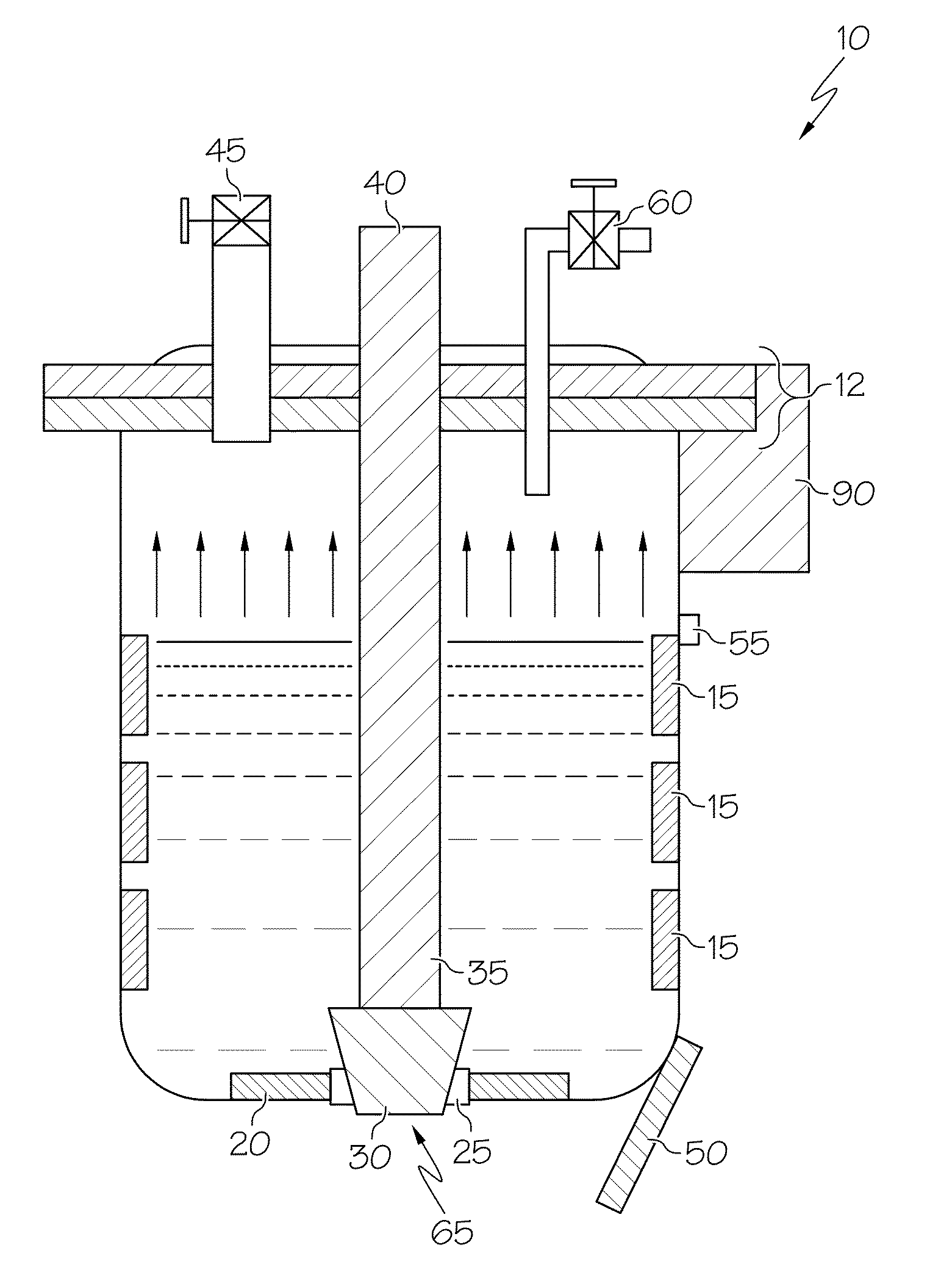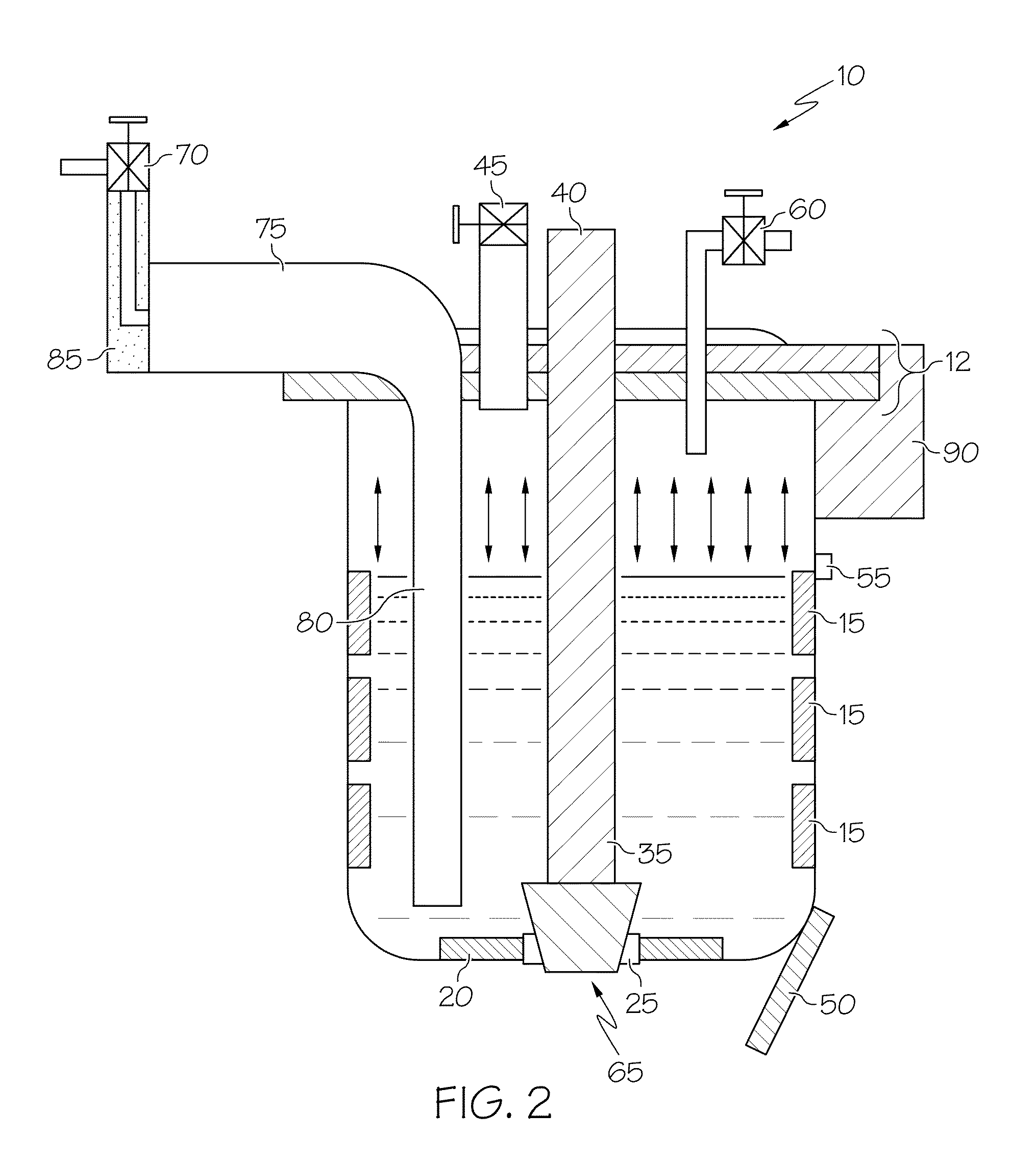[0006]In one optional form, the vessel is a pour ladle, while in another, it is a furnace. In another option, the proposed method may be used in either controlled (i.e., closed) or normal air (i.e., open) environments. The method may further include applying a vacuum while the metal or metal alloy is being cooled and heated. Additionally, the pour ladle includes a lid and vacuum valve that cooperate to form a vacuum inside the ladle during at least a portion of the time the molten metal is present therein. The pour ladle may be configured to include an aperture in its bottom, where the aperture can be selectively closed off, such as by a moveable stopper that can be controlled by an appropriate actuation mechanism. In a preferred form, the cooling and heating steps may be repeated as often as necessary to get the porosity to within a predetermined threshold. The method may additionally include adding grain-refining agents such as TiBor, eutectic-refining agents such as Al-10% Sr, or related additives to the pour ladle before filling; such a pour ladle may have a lid with a valve such that the valve is opened to facilitate the adding of such grain-refining and eutectic-modifying agents (which may be, for example, in segmented bar form), after which the valve is closed against the lid. The liquid metal or metal alloy is preferably cooled with a cooling unit positioned at or near the bottom of the pour ladle, whereas reheating of the cooled metal or metal alloy may be achieved by a zone-controlled heater or heating unit positioned on the pour ladle somewhere above the cooling unit. In this way, the molten metal or metal alloy received into the ladle is cooled from the bottom-up and reheated from the top-down as a way to promote significant increases in porosity reduction. In particular, the bottom-up cooling approach allows for the continued degassing of any previously-dissolved hydrogen as the solidification of the molten metal proceeds in an upward pattern. The heating unit and the cooling unit may be configured as part of a thermal management unit or system. Additional options may be employed for energy saving. For example, more precise control over the operation of the cooling unit and the heating unit avoids overcooling or overheating (both of which involve expending more energy than necessary to achieve the desired freezing or melting). In a particular form, the cooling unit can be used to achieve a metal temperature of about 10° C. below the solidus temperature, while the heating unit can be used achieve a metal temperature of about 20° C. above the solidus temperature.
[0007]According to another aspect of the invention, a ladle used in a metal casting operation includes a container where heating and cooling of the molten metal within the ladle is achieved by a cooling unit and a heating unit. In a particular form, the cooling unit and heating unit cooperate to provide alternate freezing (i.e., solidifying) and re-melting of the molten metal being introduced into the ladle. As discussed above in the previous aspect, the nature of the heating and cooling units is such that cooling of the molten metal within the ladle's container takes place in a bottom-up fashion. Such a configuration takes advantage of the fact that the solubility of hydrogen, oxides or other impurities (which are a significant contributor to as-cast porosity) is dramatically higher in the liquid or molten state relative to the solid state. In this way, the initial cooling, by virtue of starting at or near the bottom of the molten metal contained within the ladle, tends to force the less dense gaseous impurities that is becoming less soluble in the portion of the metal being solidified (hardened) by the cooling to take a vertically-upward path through the as-yet unsolidified molten portion. Thus, the impurities that drop out of solution continue their upward path until a substantial entirety of them have been degassed. By the time that a substantial entirety of the metal contained within the ladle has solidified, most (or all) of the hydrogen (or other gaseous impurities) that was previously held within the molten metal has been liberated. Thus, when cooling in a bottom-up manner, the gas bubbles rejected from the solidifying melt at the bottom portion can freely flow out through the top since the top is still in liquid state. Likewise, the heating of the metal (once cooled by the cooling unit) may take place in a top-down fashion to promote longer furnace or ladle life, as well as to further enhance degassing. This occurs because as the metal volume expands when it changes from solid to liquid, the expanded volume at the bottom can damage the furnace, ladle or related container if the top is still in solid state and also sticks to the furnace or ladle wall; by employing top-down melting, the gas bubbles, if still present, can also flow to the top and escape away from the molten metal.
 Login to View More
Login to View More 


